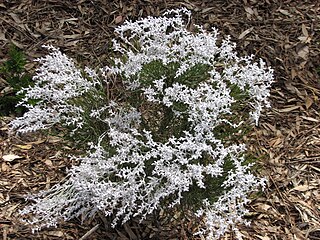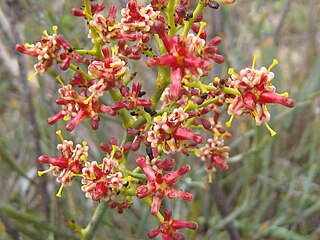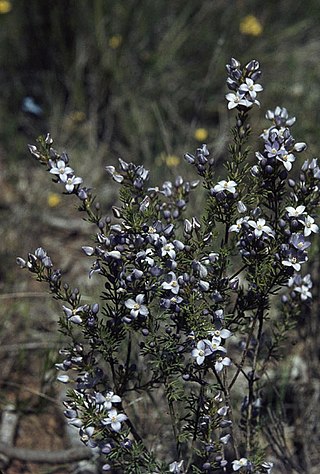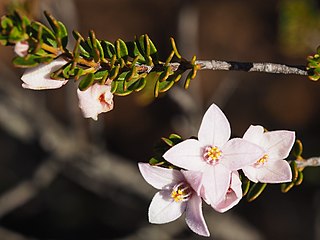
Banksia nobilis, commonly known as the golden dryandra, great dryandra or kerosene bush, is a shrub of the family Proteaceae which is endemic to Western Australia. It occurs on lateritic rises from Eneabba to Katanning in the state's Southwest Botanic Province. With large pinnatifid leaves with triangular lobes, and a golden or reddish pink inflorescence, it is a popular garden plant. It was known as Dryandra nobilis until 2007, when all Dryandra species were transferred to Banksia by Austin Mast and Kevin Thiele. There are two subspecies, B. nobilis subsp. nobilis and B. nobilis subsp. fragrans.

Banksia proteoides, commonly known as king dryandra, is a shrub endemic to Western Australia. It was known as Dryandra proteoides until 2007, when all Dryandra species were transferred to Banksia by Austin Mast and Kevin Thiele.
Conospermum glumaceum, commonly known as hooded smokebush, is a shrub endemic to Western Australia.

Conospermum stoechadis, commonly known as common smokebush, is a shrub endemic to Western Australia.
Conospermum stoechadis subsp. sclerophyllum is a shrub endemic to Western Australia.

Conospermum incurvum, commonly known as plume smokebush, is a shrub endemic to Western Australia.

Stirlingia simplex is a plant endemic to Western Australia.

Stirlingia latifolia, commonly known as blueboy, is a plant endemic to Western Australia.

Anigozanthos humilis is a species of Anigozanthos in the family Haemodoraceae. This flowering perennial plant is endemic to Southwest Australia and widespread in its open forests. Common names include catspaw and common catspaw.

Isopogon sphaerocephalus, commonly known as drumstick isopogon or Lesueur isopogon, is a species of plant in the family Proteaceae and is endemic to the south-west of Western Australia. It is a shrub with linear to narrow egg-shaped leaves and spherical heads of hairy white to creamy yellow flowers.

Adenanthos barbiger, the hairy jugflower or hairy glandflower, is a species of shrub in the family Proteaceae. It is endemic to the south-west of Western Australia. It usually grows to 1 metre high, and has bright red flowers that appear mostly between August and December. The species was first formally described in 1839 by English botanist John Lindley in A sketch of the vegetation of the Swan River colony.

Scaevola platyphylla, commonly known as broad-leaved fanflower, is a shrub in the family Goodeniaceae. It is endemic to the south-west of Western Australia. Plants grow to between 0.3 and 1.3 metres high and have blue to purple flowers that appear between August and January in their native range.

Thelymitra antennifera, commonly called the rabbit-eared sun orchid, lemon-scented sun orchid or vanilla orchid is a species of orchid which is native to Western Australia, South Australia and Victoria and northern parts of Tasmania.

Johnsonia pubescens, commonly called the pipe lily, is a grass-like plant in the family Asphodelaceae, subfamily Hemerocallidoideae, endemic to the south-west of Western Australia. As with others in the genus, it is distinguished by its minute flowers which are on the end of a spike and hidden by large, overlapping, papery bracts.

Burchardia congesta is a perennial herb in the family Colchicaceae, and is native to Western Australia.

Cyanothamnus ramosus is a species of plant in the citrus family Rutaceae and is endemic to the southwest of Western Australia. It is an erect, mostly glabrous shrub with pinnate leaves with up to seven leaflets, and white, four-petalled flowers with blue or pale green backs.

Boronia scabra, commonly known as rough boronia, is a plant in the citrus family, Rutaceae and is endemic to the south-west of Western Australia. It is an open shrub with simple, often clustered, oblong to elliptic leaves, and pink, mostly four-petalled flowers.

Philotheca nodiflora is a species of flowering plant in the family Rutaceae and is endemic to Western Australia. It is a weak shrub with more or less cylindrical leaves and blue to pink flowers arranged in compact heads.

Lasiopetalum glutinosum is a species of flowering plant in the family Malvaceae and is endemic to the south-west of Western Australia. It is a spreading, multi-stemmed shrub with densely hairy young stems, egg-shaped leaves often with three lobes and bright pink or dark red flowers.

Conostylis caricina is a flowering plant in the family Haemodoraceae and is endemic to the south-west of Western Australia. It is a rhizomatous, tufted perennial, grass-like plant or herb with flat leaves and heads of 6 to 8 creamy-yellow flowers.

















